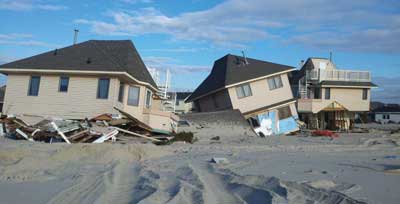 |
| (1) 2nd Avenue along the Ortley Beach oceanfront. (Photo by James Bonelli.) (See sidebar “Morris County Task Force-1’s Deployment to New Jersey’s Barrier Islands.”) |
By JACK J. MURPHY
As Hurricane Sandy barreled up the Atlantic coastline, New Jersey fire departments, including the Leonia Fire Department (LFD), began prepping for the storm. Departments went from local to mutual-aid responses and on to state task force responses. Under these trying conditions, departments looked to adopt protocols that normally did not affect our region on a regular basis. The Bergen County Region looked to The Miami-Dade Fire Rescue Department Policy and Procedure Manual “Hurricane Procedures” and the International Association of Fire Chiefs Model Procedures for Response of Emergency Vehicles During Hurricanes and Tropical Storms for assistance. Both of these documents proved to be sound guidelines for response, for when not to respond, and on the havoc that saltwater plays on fire apparatus.
LOCAL: LFD RESPONSE
During the hurricane watch period, Leonia held preimpact preparedness meetings with town leaders to strategize and implement a community crisis response plan. When Sandy made landfall on October 29, LFD, like many Bergen County fire departments, responded to numerous emergency incidents ranging from down wires to wind-damaged structures, flooding, gas leaks, and other perilous conditions. Response procedures were in place; all fire personnel staffed the station while setting up a mobile field communication unit to handle numerous calls for assisting the county communication center with dispatching. Locally, responses to alarms would continue until the hurricane-force winds would dictate an action for emergencies. Fifty mile-per-hour (mph) sustained winds would dictate rescue operations, while sustained winds greater than 60 mph would terminate suppression operations until they were deemed safe.
COUNTY: MUTUAL-AID RESPONSE TO MOONACHIE/LITTLE FERRY
At 0115 hours, the Bergen County Emergency Operations Center requested rescue boats from several mutual-aid groups to respond to the Moonachie and Little Ferry fire districts to assist in evacuating people in flooded areas. Sandy caused a high water surge along the Hackensack River. Although these communities are several miles inland from the lower New York City bay, this surge trapped thousands of residents unexpectedly. All of Moonachie had to be evacuated along with a large area of Little Ferry.
LFD Rescue and Boat deployed a mutual-aid group boat assigned to Moonachie to assist with the evacuations. Because of flooding in the entire area, response directions were issued for travel on Route 80 West, Route 17 South, Route 3 East, and Route 120 North. However, because of excessive flooding, LFD Rescue had to reroute; circumstances dictated arrival at the designated staging area along Route 120 North.
At the boat launch/staging area, we informed the South Bergen coordinator that LFD Rescue and Boat was on the scene at the South Sector Command Post (S/CP). After reporting to the staging chief, LFD Boat received directions to begin searching a designated area, taking any evacuees to a dry ground area near the Burger King parking lot on Washington Avenue. From there, high-wheeled municipal vehicles would take the evacuees to a designated temporary shelter. The evacuees ranged from a six-week old baby to a person who weighed more than 500 pounds.
The Moonachie Fire Department’s (MFD’s) rescue efforts were coordinated with S/CP that was staffed by the MFD’s and Carlstadt Fire Department’s chiefs and other personnel. Assisting with the rescue efforts in this area were other crafts from the towns of Wallington; River Vale; Emerson; Washington Township; Rochelle Park; New Milford; Woodcliff Lake; and Oradell, which sent two boats. A commercial building near the S/CP was opened to house other support agencies and act as a drop-off point for evacuees.
At approximately 0600 hours, S/CP notified all boats in this sector to break down because the water line was receding; the rescue would continue using National Guard military vehicles. Other rescue relief groups from the State Urban Search & Rescue team and the county fire departments were deployed to continue with the evacuation through the day. At 0645 hours, LFD Rescue and Boat was deactivated.
Later that day, a second mutual-aid request was made for a LFD engine to report back to the affected area and stage at the temporary shelter at the Bergen Vo-Tech High School in nearby Teterboro. The duty crew would assist the Little Ferry Fire Department (LFFD) and the county coordinator with the various tasks at hand; the deployed time period was eight hours. During these rescue efforts, a multialarm fire occurred in Saddle Brook within the same mutual-aid group that had many towns already committed to the Moonachie and Little Ferry floods. A request for an out-of-mutual-aid response was made to the County Office of Emergency Management (OEM) Center for two engines (Hillsdale and Wallington) and a ladder from Palisades Park.
STATE: BERGEN COUNTY TASK FORCE-1 (BC/TF-1) AND TOMS RIVER
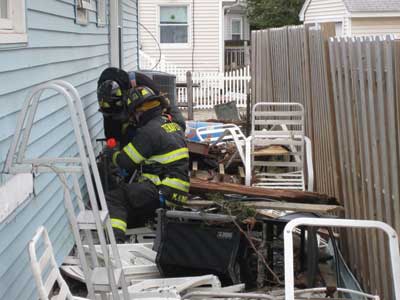 |
| (2) Bergen County Task Force-1 (BC/TF-1) firefighters isolate a gas utility during a door-to-door search in the Silverton section. (Photos by Mark Fredrick.) |
On October 31 at 1330 hours, the Bergen County fire coordinator announced that the county was forming the first of six task force groups (BC/TF-1) for deployment to Toms River within three hours. This countywide task force was made up of a county deputy fire coordinator, a ladder company, three engine companies, an EMS unit, and a field communications unit. BC/TF-1, consisting of county mutual-aid groups from Leonia, Mahwah, Fair Lawn, and Tenafly, assembled for a 24- to 48-hour deployment time period; hastily gathered food and other perishables; and met at the Vince Lombardi rest stop on the New Jersey Turnpike. Before departing the county staging area, a state response personnel check-in list for accountability and equipment was compiled. At 1645 hours, the BC/TF-1 leader notified the county that it was leaving the staging area and that the Tenafly ladder would be 30 minutes behind.
The task force arrived at the Ocean County staging area at Garden State Parkway Exit 82 (Toms River Center) off Route 37 East at approximately 1825 hours. After the hurricane, a sustained emergency was in effect. Many hazards had been encountered during the first 48 hours after the storm, and Ocean County firefighters who worked these hours needed relief.
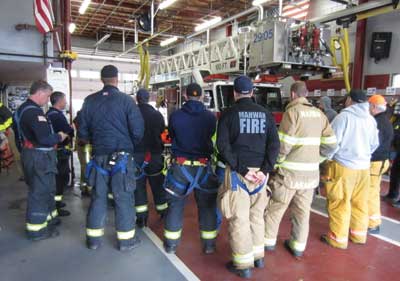 |
| (3) BC/TF-1 at a Toms River debriefing meeting awaiting its next assignment. |
On meeting with the Ocean County fire coordinator’s personnel, the BC/TF-1was assigned to the Toms River Fire Department’s Substation 26 off Hooper Avenue; Station 26 had relocated to a substation because its main firehouse was evacuated because of high surging water levels off the bay. The substation also became the secondary fire communications center for dispatching apparatus. Soon after a situation briefing was held by the local chief, all the task force vehicles were refueled. The local Department of Public Works facility was the only pumping station working in the area; it had standby power. Fortunately, the local hydrant grid system was fully intact.
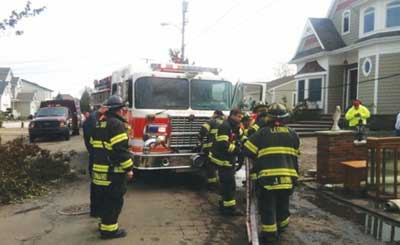 |
| (4) BC/TF-1 at a Toms River car fire overhauling the vehicle near a building. (Photo by Richard Quinton Jr.) |
BC/TF-1 established response protocols for structure fires (all-hands response) and for other emergencies; one engine, the ladder, and an EMS unit would respond. Effective communication was a key for the task force. The Leonia Field Communications Unit (FCU) had the mobile capabilities to patch in spare portable radios for linking two companies that did not have compatible communications with the other task force companies. The deployment of the FCU and the EMS unit along with this task force proved valuable. Throughout the first evening, carbon monoxide (CO) incidents caused by alternative fuel-fired generators were predominant. During several of these calls, the EMS unit assisted with patients who were exposed to high CO levels. While responding to an overturned home fuel tank that was leaking into the bay off Pelican Island, we discovered occupants from two homes who had waited out the storm.
SILVERTON FIRE DISTRICT
On November 1 at approximately 1100 hours, BC/TF-1 was relieved by a Warren County task force and reassigned to Silverton’s Station 29. The Silverton bay area had experienced surging water levels between six and nine feet, forcing evacuations from numerous one- and two-family homes. At the height of the storm, Station 29 performed many water rescues in rapid water conditions, but as the force of the ocean current became more perilous, operations were halted for the firefighters’ safety. BC/TF-1 played a part in regrouping to continue a door-to-door search in coordination with the local police department. Safety and hazard identification was conducted in each structure for victims; to isolate electric and gas utilities; and to mark the buildings relative to the status of isolations for gas (G), electric (E), and searched (S) or if the occupants were staying (O). The BC/TF-1 was divided into four teams; each was accompanied by a police officer. This assignment was halted at 1800 hours because of darkness, and all units returned to Station 29.
At 1930 hours, other task force groups from across the state were assigned to cover emergency incident responses. At this time, Fair Lawn returned to its borough, Leonia and Tenafly swapped out duty crews and continued their door-to-door searches in the early morning hours, and Mahwah remained at Station 29.
On November 2, the second duty crews from Leonia and Tenafly conducted various assignments such as door-to door searches and were assigned to other needs at Station 29. During the day, the local chief released the Mahwah (1100 hours), Tenafly (1400 hours), and Leonia (1930 hours) crews. They returned to their boroughs. During more than 1,047 deployment hours, only two minor injuries were reported. All responding Bergen County units were advised to have their apparatus and turnout gear decontaminated on returning to their boroughs.
After BC/TF-1 responded, many fire departments notified the county fire coordinator that they were available for a task force response. BC/TF-2, consisting of Park Ridge, River Vale, Westwood, Ramsey, and Upper Saddle River crews, was deployed on November 2 and Ridgefield’s water tender was deployed to Essex County on November 3 for water issues in the area. On November 4, BC/TF-3, consisting of River Edge, Fair Lawn, and Ridgewood, was deployed, and BC/TF-4 departed on November 6.
Morris County Task Force-1’s Deployment to New Jersey’s Barrier Islands
By JAMES BONELLI
 |
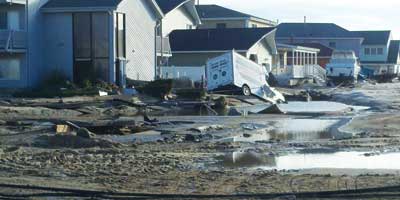 |
| (1, 2) Intersection of 2nd Avenue and Route 35 North in Ortley Beach, New Jersey. (Photos by author.) |
On October 28, 2012, 21 county fire coordinators prepared fire department personnel for Hurricane Sandy at the New Jersey State Regional Operations Intelligence Center (ROIC). Information on specialized teams was being gathered with an emphasis on requests for swift water rescue teams, fire boats, and so on. Chiefs were given a list of preparedness topics on family, facility, and personnel.
During the storm, response criteria were defined for rescue operations, which would be terminated if sustainable winds exceeded 50 miles per hour (mph); suppression operations would be terminated with winds of 60 mph. All preparations had been completed: Fire apparatus were prepped, crews were assigned, and tools and equipment were double-checked. The only thing left was Sandy’s arrival.
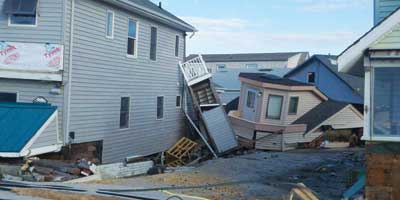 |
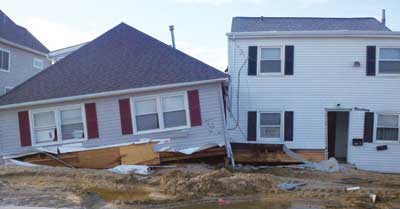 |
| (3, 4) 2nd Avenue along the Ortley Beach oceanfront. |
On October 29, situation information updates were being reviewed from the state and county office of emergency management (OEM) throughout the day. Some of the local problems encountered were power outages and the county trunk radio system’s being out of service. Morris County had more than 32 apparatus unable to respond because of down trees and wires and other storm-related conditions.
On October 30, Morris County Fire Coordinator Jack Alderton sent out requests to county chiefs for information on the following:
- 1. Staffing levels for the day.
- 2. Staffing for the rest of the week.
- 3. Accessibility levels in and out of town.
- 4. Power to the firehouse on a generator.
- 5. Willingness to be deployed out of county for the next six hours.
On October 31, Ocean County Fire Coordinator Brian Gabriel requested a fire suppression task force through the ROIC, and Morris County departments were advised to deploy between 24 and 72 hours. At 1030 hours, Alderton contacted the towns of Lincoln Park, Brookside, Morris Plains, Mount Arlington, Pequannock, and Roxbury to form two Morris County task forces (MC/TF-1 and MC/TF-2). These task forces were asked to meet at the county fire academy by 1300 hours for deployment.
As the chief of the Pequannock (NJ) Fire Department (PFD), I phoned my personnel and assembled eight members to deploy by 1200 hours and commit to the 72-hour deployment period; members only had 90 minutes to assemble. MC/TF-1 consisted of a Brookside engine, a Mount Arlington quint, and a PFD Rescue and chief’s vehicle. MC/TF-2 consisted of two Lincoln Park engines and a Roxbury engine.
Prior to departing to the county staging area, we were informed that no food or water would be available in Ocean County. A local grocery store, which had electrical power and was open for business, supplied us for a possible three-day deployment. MC/TF-1 departed south at 1330 hours. At 1600 hours, a second request was made for a fire suppression task force (MC/TF-2).
 |
| (5) Along the Seaside Heights boardwalk. |
After a 1½-hour drive south, we arrived at the designated staging area-the Toms River Shopping Mall. Other fire apparatus from around the state were also beginning to arrive. Once we checked into staging, we waited approximately one hour before being relocated to a forward staging area at the base of the Route 37 bridge. This bridge was the access point to the barrier island, which was one of the hardest-hit areas of the state; the PFD was one of the first departments assigned to the island.
Gabriel met our task force at the bridge and immediately escorted us to the barrier island. Once on the island, we proceeded north to Ocean Beach. At the Ocean Beach Station 3, just yards from the Atlantic Ocean, local firefighters were exhausted but still responding to emergencies. The firefighters stated that during the night there were approximately 52 structure fires.
The entire area was in total darkness, the station’s standby generator was out of service because of flooding, and all utilities were out. Station 3 was our home base for the next few days. Task force firefighters set up portable lighting and charging stations. Bathroom utilities were also a concern. Tables, chairs, and other provisions were set up across the street inside a home under construction. Contractors procured a portable toilet that was sitting outside the home by wrapping it in rope. Much to our amazement, the toilet and its toilet paper were completely dry.
Once set up, MC/TF-1 worked with Ocean Beach Company 3 to respond to reported area emergencies such as gas leaks. Around the area, homes were moved off their foundations, roadways were washed out, and entire neighborhoods went completely missing. Moving around the response district had to be done cautiously because of compromised roadways. Some roads were washed out completely; some had structures in the middle of the street. Down utility poles and wires blocked many means of access points.
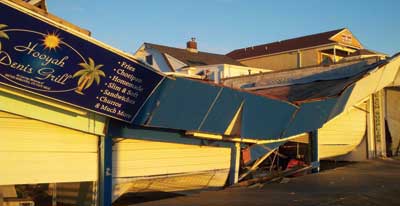 |
| (6) An example of wave damage on the Seaside Heights boardwalk. |
The barrier island had two main highways that go north to south. Route 35 North is a two-lane highway one block from the ocean; it suffered major damage. Route 35 South was used to move both northbound and southbound traffic. Fire apparatus were staged on the main roads to supply lighting while members walked into the blocks covered with mounds of sand. Many homes that were ripped off their foundations had broken gas lines; some could be secured by the service valve; others were broken below the surface. Gas mains were broken and holes in the sand could be seen emitting gas. Door-to-door house checks were conducted in the 10-block area. A hazards list was compiled. After completing these tasks, the detail members returned to Station 3. We were then instructed to relocate south to the Seaside Heights Fire Department Headquarters (SHFD/HQ). At 2100 hours, we arrived at SHFD/HQ, where we met up with MC/TF-2.
Both task forces staged in a parking lot next to fire headquarters; at this time, we were informed that our response district would cover an approximately 45-square-mile area. Bed cots were at a premium; most MC/TF firefighters slept in cars or apparatus. We wanted local firefighters to get first choice of cots. Fire calls during the rest of the night were few; all residents had evacuated the island.
On November 1, we remained in staging. Information was scarce, but responses to down wires continued. MC/TF-1 was requested to secure gas in a 14-block area of Seaside Heights. In this area, most gas meters are outside the structures. A local resident was found in his home and requested to leave the area. Covered in mud, he stated that he rode the storm out on top of his dresser; he was transported to the mainland. After completing this task, we returned to SHFD/HQ. At approximately 1800 hours, MC/TF-2 was released.
On November 2 at 1000 hours, MC/TF-1 was released. After checking out at the command post, we decontaminated all vehicles.
JAMES BONELLI is a 33-year fire service veteran and the chief of the Pequannock (NJ) Fire Department. He also has served 21 years as a career firefighter with the Passaic (NJ) Fire Department and is a captain assigned to a ladder company. He has worked at FDIC and is an instructor with Passaic County (NJ) Fire Academy. Bonelli is also an instructor with Fire Ground Technologies, a training company of Fire Department of New York members specializing in bailout.
● JACK J. MURPHY, MA, is a fire marshal (ret.), a former deputy chief for the Leonia (NJ) Fire Department, and a deputy fire coordinator for the New Jersey Division of Fire Safety-Bergen Region. He is also the chairman of the New York City High-Rise Fire Safety Directors Association and a member of the National Fire Protection Association High-Rise Building Safety Advisory and Pre-Incident Planning Committees. He has published various fire service articles and authored RICS: Rapid Incident Command System Field Handbook, the “Pre-Incident Planning” chapter of Fire Engineering’s Handbook for Firefighter I and II, and co-authored Bridging the Gap: Fire Safety and Green Buildings with Jim Tidwell. He is an FDIC executive advisory board member and a contributing editor to Fire Engineering. Murphy received the 2012 Fire Engineering Tom Brennan Lifetime Achievement Award.
Enter 157 at fireeng.hotims.com
Fire Engineering Archives

